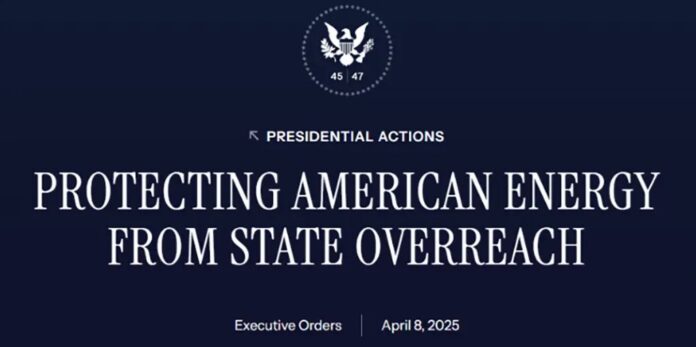By Steve Goreham
A version of this article was originally published in The Wall Street Journal.
Hydrocarbon fuel producers gain a powerful ally with Trump’s order challenging rules to promote renewable energy.
In the Trump administration’s first 100 days, advocates for climate policy have been hit by actions to close climate departments, halt offshore wind leases, cut green energy funding, and impose tariffs on renewable equipment imports from China. Just when it seemed things couldn’t get worse, President Trump has ordered the federal government to challenge state climate laws.
Last month the President issued an executive order titled, “Protecting American Energy from State Overreach.” The order said that state laws “seek to regulate energy beyond their constitutional or statutory authorities.” It mentioned laws in California, New York, and Vermont and used the term “extortion law.” The order directed U.S. Attorney General Pam Bondi to “identify all state and local laws … burdening the identification, development, siting, production, or use of domestic energy resources that are or may be unconstitutional, preempted by federal law, or otherwise unenforceable” within 60 days. It also directed her to recommend “Presidential or legislative action” necessary to stop the enforcement of these laws. The federal government is now entering the climate battle on the side of producers of hydrocarbon energy, meaning coal, gas, and oil.
For the last 10 years, left-leaning states have enacted regulations to block the use of coal, gas, and oil and to force the adoption of renewable energy. These laws exceed states’ legal authority, aiming to dictate national and international energy policy. States and cities have imposed regulations and monetary penalties on producers of hydrocarbon energy that emit carbon dioxide when used. Businesses that consume hydrocarbons are forced to pay large sums to “trade” carbon credits. Coal, gas, and oil companies spend millions on legal fees to defend their right to produce energy.
In May 2024, Vermont passed its Climate Superfund Act holding “fossil fuel extractors” or “crude oil refiners” responsible for “costs due to climate change.” Vermont seeks millions of dollars in damages from companies that produced fuel connected to more than a billion metric tons of global greenhouse-gas emissions from 1995 through 2024. The law’s supporters blame Vermont’s July 2023 floods on climate change caused by emissions from oil companies. They apparently do not remember the Great Vermont Flood of 1927, the worst flood in the state’s history, which happened when global CO2 emissions were only ten percent of today’s. Vermont Lieutenant Governor S. Hollister was killed in the 1927 flood after getting out of his car into flood waters.
New York enacted its own version, the Climate Change Superfund Act, in December. That law imposes a huge tax on hydrocarbon fuel companies, an estimated collective total of $3 billion a year, beginning in 2028.
Like Vermont, New York seeks payments from firms that produced fuel connected with global emissions of more than a billion tons of CO2 from a past period, in this case 2000 through 2018. In February, a coalition of 22 states along with several industry associations filed a lawsuit against New York officials responsible for implementing and enforcing the law.
Among other climate impacts, the New York act blames “rising sea levels” on the “historical polluters.” It is true that sea levels at The Battery Gauge in New York rose 0.96 feet from 1856 to 2024, a rate of almost seven inches per century. But the National Aeronautics and Space Administration has pointed out that ocean levels rose about 390 feet in the last 20,000 years. No scientist knows when natural sea-level rise ended, and human-caused sea-level rise began.
Maryland passed its Responding to Emergency Needs from Extreme Weather (RENEW) Act this month, seeking to “make polluters pay.” Legislators appear to believe that greenhouse gas emissions are causing extreme weather and storms to get stronger.
But evidence from satellites does not show that storms are becoming more frequent or stronger. Dr. Ryan Maue, formerly chief scientist at the National Oceanic and Atmospheric Administration, shows that the number of global tropical cyclones (hurricanes and tropical storms) has not been increasing over the last 50 years. Since 2006, the accumulated cyclone energy of tropical cyclones has declined to the lowest level since the 1970s.
Efforts to enact “superfund” laws to seek monetary damages from fuel companies are also underway in California and Massachusetts. Voters rejected a similar proposed statute this month in Oregon. But Maryland, New York, and Vermont laws have serious legal weaknesses. The Constitution explicitly states that neither the Congress nor any state may pass an “ex post facto Law,” which imposes criminal liability for past actions that weren’t restricted at the time. The Maryland, New York, and Vermont acts all propose to tax companies retroactively for legally producing fossil fuels.
The 1970 Clean Air Act gives the Environmental Protection Agency the responsibility for establishing air pollution standards. States have responsibility for local and indoor air pollution, but not nationwide or global air pollution, as the superfund laws appear to cover.
Related
Discover more from Watts Up With That?
Subscribe to get the latest posts sent to your email.





